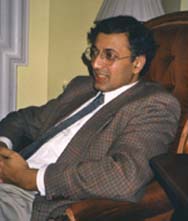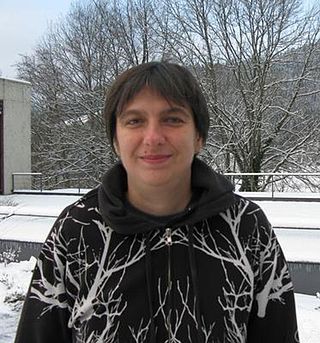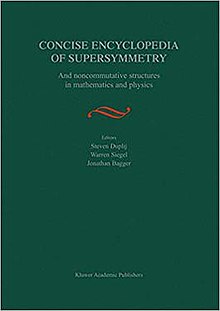M-theory is a theory in physics that unifies all consistent versions of superstring theory. Edward Witten first conjectured the existence of such a theory at a string theory conference at the University of Southern California in 1995. Witten's announcement initiated a flurry of research activity known as the second superstring revolution. Prior to Witten's announcement, string theorists had identified five versions of superstring theory. Although these theories initially appeared to be very different, work by many physicists showed that the theories were related in intricate and nontrivial ways. Physicists found that apparently distinct theories could be unified by mathematical transformations called S-duality and T-duality. Witten's conjecture was based in part on the existence of these dualities and in part on the relationship of the string theories to a field theory called eleven-dimensional supergravity.
In physics, string theory is a theoretical framework in which the point-like particles of particle physics are replaced by one-dimensional objects called strings. String theory describes how these strings propagate through space and interact with each other. On distance scales larger than the string scale, a string looks just like an ordinary particle, with its mass, charge, and other properties determined by the vibrational state of the string. In string theory, one of the many vibrational states of the string corresponds to the graviton, a quantum mechanical particle that carries the gravitational force. Thus, string theory is a theory of quantum gravity.
A timeline of atomic and subatomic physics.

Mathematical physics refers to the development of mathematical methods for application to problems in physics. The Journal of Mathematical Physics defines the field as "the application of mathematics to problems in physics and the development of mathematical methods suitable for such applications and for the formulation of physical theories". An alternative definition would also include those mathematics that are inspired by physics.
In a supersymmetric theory the equations for force and the equations for matter are identical. In theoretical and mathematical physics, any theory with this property has the principle of supersymmetry (SUSY). Dozens of supersymmetric theories exist. Supersymmetry is a spacetime symmetry between two basic classes of particles: bosons, which have an integer-valued spin and follow Bose–Einstein statistics, and fermions, which have a half-integer-valued spin and follow Fermi–Dirac statistics. In supersymmetry, each particle from one class would have an associated particle in the other, known as its superpartner, the spin of which differs by a half-integer. For example, if the electron exists in a supersymmetric theory, then there would be a particle called a selectron, a bosonic partner of the electron. In the simplest supersymmetry theories, with perfectly "unbroken" supersymmetry, each pair of superpartners would share the same mass and internal quantum numbers besides spin. More complex supersymmetry theories have a spontaneously broken symmetry, allowing superpartners to differ in mass.
Noncommutative geometry (NCG) is a branch of mathematics concerned with a geometric approach to noncommutative algebras, and with the construction of spaces that are locally presented by noncommutative algebras of functions. A noncommutative algebra is an associative algebra in which the multiplication is not commutative, that is, for which does not always equal ; or more generally an algebraic structure in which one of the principal binary operations is not commutative; one also allows additional structures, e.g. topology or norm, to be possibly carried by the noncommutative algebra of functions.
Superspace is the coordinate space of a theory exhibiting supersymmetry. In such a formulation, along with ordinary space dimensions x, y, z, ..., there are also "anticommuting" dimensions whose coordinates are labeled in Grassmann numbers rather than real numbers. The ordinary space dimensions correspond to bosonic degrees of freedom, the anticommuting dimensions to fermionic degrees of freedom.

Jean-Pierre Vigier was a French theoretical physicist, known for his work on the foundations of physics, in particular on his stochastic interpretation of quantum physics.

George Whitelaw Mackey was an American mathematician known for his contributions to quantum logic, representation theory, and noncommutative geometry.
In mathematical physics, noncommutative quantum field theory is an application of noncommutative mathematics to the spacetime of quantum field theory that is an outgrowth of noncommutative geometry and index theory in which the coordinate functions are noncommutative. One commonly studied version of such theories has the "canonical" commutation relation:

Rudolf Haag was a German theoretical physicist, who mainly dealt with fundamental questions of quantum field theory. He was one of the founders of the modern formulation of quantum field theory and he identified the formal structure in terms of the principle of locality and local observables. He also made important advances in the foundations of quantum statistical mechanics.

Usually non-critical string theory is considered in frames of the approach proposed by Polyakov. The other approach has been developed in. It represents a universal method to maintain explicit Lorentz invariance in any quantum relativistic theory. On an example of Nambu-Goto string theory in 4-dimensional Minkowski space-time the idea can be demonstrated as follows:

Shahn Majid is an English pure mathematician and theoretical physicist, trained at Cambridge University and Harvard University and, since 2001, a Professor of Mathematics at the School of Mathematical Sciences, Queen Mary, University of London.
In mathematics, a sequence of n real numbers can be understood as a location in n-dimensional space. When n = 8, the set of all such locations is called 8-dimensional space. Often such spaces are studied as vector spaces, without any notion of distance. Eight-dimensional Euclidean space is eight-dimensional space equipped with the Euclidean metric.
Warren Siegel is a theoretical physicist specializing in supersymmetric quantum field theory and string theory. He is a professor at the C. N. Yang Institute for Theoretical Physics at Stony Brook University in New York.

Matilde Marcolli is an Italian and American mathematical physicist. She has conducted research work in areas of mathematics and theoretical physics; obtained the Heinz Maier-Leibnitz-Preis of the Deutsche Forschungsgemeinschaft, and the Sofia Kovalevskaya Award of the Alexander von Humboldt Foundation. Marcolli has authored and edited numerous books in the field. She is currently the Robert F. Christy Professor of Mathematics and Computing and Mathematical Sciences at the California Institute of Technology.
Albert J. Crumeyrolle (1919–1992) was a French mathematician and professor of mathematics at the Paul Sabatier University, known for his contributions to spinor structures and Clifford algebra.

Simon Wolfe Saunders is a British philosopher of physics. He is noted for his work on quantum mechanics, on identity and indiscernibility in physics, and on structural realism.
Ali H. Chamseddine is a Lebanese physicist known for his contributions to particle physics, general relativity and mathematical physics. As of 2013, Chamseddine is a physics Professor at the American University of Beirut and the Institut des hautes études scientifiques.

Sergio Doplicher is an Italian mathematical physicist, who mainly dealt with the mathematical foundations of quantum field theory and quantum gravity.









